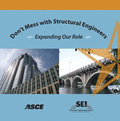Structural and Environmental Stabilization of a Historic Wood-Framed Museum
Publication: Structures Congress 2009: Don't Mess with Structural Engineers: Expanding Our Role
Abstract
The Antelope Valley Indian Museum is a historic one- and two-story wood-framed structure, built in the late 1920s through the 1930s near Lancaster, California. Given that the museum collection was inadequately protected from temperature fluctuations, the State of California embarked on an ambitious program to insulate the building, heat and cool the museum using geothermal heat exchangers, and structurally and seismically strengthen the building. The existing structure was not engineered and was built in several phases with a minimum of structural framing components and connections, even considering standard construction practices in the 1920s and 1930s. The addition of insulation and associated wood framing to the roof of the museum adds a significant amount of weight — nearly doubling the weight of the structure. As the interior finishes are actually the exposed structural elements, structural strengthening to protect the historic elements of the building can result in the diminishment or destruction of the very historic elements one is trying to protect — particularly if the strengthening is not performed judiciously; consequently any structural intervention must be carefully weighed against the potential impacts on the historic fabric and against the cost of the work. This paper addresses the stabilization measures that are currently in the process of being implemented, focusing primarily on the structural aspects of the project. In terms of structural strengthening, the authors selected an unusual arrangement of angled and inclined external stainless steel wire ropes (tension guy wires) to provide increased lateral stability, and horizontal internal wire ropes (tension collar ties) to increase the vertical load capacity of the gabled roof areas. The tension guy wire ropes lend themselves fairly well to bracing this light structure; since they connect directly to the roof joists, the wire ropes take lateral forces directly down to either stainless steel eyebolts epoxied into the surrounding rock or small concrete anchor blocks. The tension collar ties are used to create trusses out of the inclined gabled roof joists. Since the wire ropes are relatively unobtrusive, since they are clearly not part of the original construction, and since they are almost wholly reversible, the addition of wire ropes appeared to be a reasonable solution for the majority of the museum.
Get full access to this article
View all available purchase options and get full access to this chapter.
Information & Authors
Information
Published In
Copyright
© 2009 American Society of Civil Engineers.
History
Published online: Apr 26, 2012
ASCE Technical Topics:
- Architectural engineering
- Building insulation
- Building systems
- Buildings
- Engineering mechanics
- Facilities (by type)
- Frames
- Historic buildings
- History and Heritage
- Practice and Profession
- Public buildings
- Statics (mechanics)
- Structural behavior
- Structural engineering
- Structural members
- Structural stability
- Structural strength
- Structural systems
- Structures (by type)
- Wood frames
- Wood structures
Authors
Metrics & Citations
Metrics
Citations
Download citation
If you have the appropriate software installed, you can download article citation data to the citation manager of your choice. Simply select your manager software from the list below and click Download.
